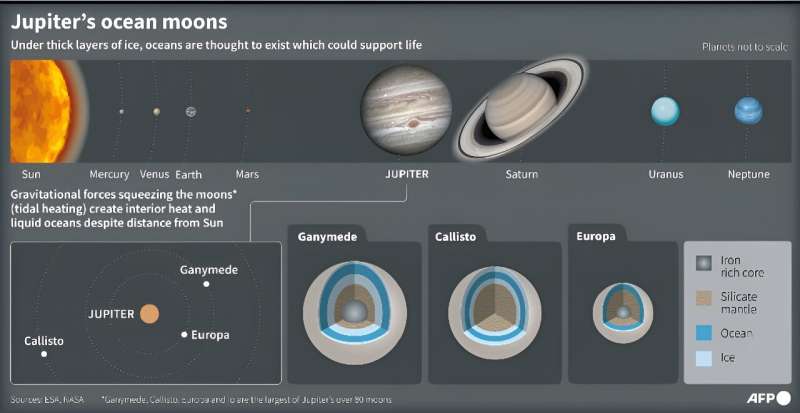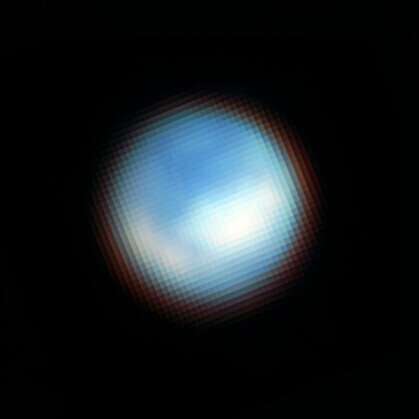Carbon dioxide detected on Jupiter’s moon Europa comes from the vast ocean beneath its icy shell, research using James Webb Space Telescope data indicated on Thursday, potentially bolstering hopes the hidden water could harbor life.
Scientists are confident there is a huge ocean of saltwater kilometers below Europa’s ice-covered surface, making the moon a prime candidate for hosting extra-terrestrial life in our Solar System.
But determining whether this concealed ocean has the right chemical elements to support life has been difficult.
Carbon dioxide—one of the key building blocks of life—has been detected on Europa’s surface, but whether it rose up from the ocean below remained an open question.
Aiming to find an answer, two US-led teams of researchers used data from the Webb telescope’s near-infrared spectrometer to map CO2 on the surface of Europa, publishing their results in separate studies in the journal Science.
The most CO2 was in a 1,800 kilometer-wide (1,120 mile) area called Tara Regio, where there is a lot of “chaos terrain” with jagged ridges and cracks.
Exactly what creates chaos terrain is not well understood, but one theory is that warm water from the ocean rises up to melt the surface ice, which then re-freezes over time into new uneven crags.

The ESA’s Juice probe launched in April on a mission to explore Jupiter’s icy moons.
The first study used the Webb data to look at whether the CO2 could have come from somewhere other than the ocean below—hitching a ride on a meteorite, for example.
Samantha Trumbo, a planetary scientist at Cornell University and the study’s lead author, told AFP they concluded that the carbon was “ultimately derived from the interior, likely the internal ocean”.
But the researchers could not rule out that the carbon came up from the planet’s interior as rock-like carbonate minerals, which irradiation could then have broken apart to become CO2.
‘Very exciting’
Table salt has also been detected in Tara Regio—making the area significantly more yellow than the rest of Europa’s scarred white plains—and scientists think it may also have come up from the ocean.
“So now we’ve got salt, we’ve got CO2: we’re starting to learn a little bit more what that internal chemistry might look like,” Trumbo said.

Webb’s NIRCam (Near Infrared Camera) captured this picture of the surface of Jupiter’s moon Europa. Webb identified carbon dioxide on the icy surface of Europa that likely originated in the moon’s subsurface ocean. This discovery has important implications for the potential habitability of Europa’s ocean. The moon appears mostly blue because it is brighter at shorter infrared wavelengths. The white features correspond with the chaos terrain Powys Regio (left) and Tara Regio (center and right), which show enhanced carbon dioxide ice on the surface. A blue-and-white sphere against a black background is somewhat reminiscent of the famous “Blue Marble” picture of Earth from space. With fuzzy, diffuse edges, this sphere features darker blue patches in most of the northern hemisphere facing the viewer. One, large, crescent-shaped, white patch extends along the left side of the southern hemisphere facing the viewer, and a larger, blobby, white patch covers the middle latitudes of the right side of the southern hemisphere. Lighter blue regions border these white patches in the south. © NASA, ESA, CSA, G. Villanueva (NASA/GSFC), S. Trumbo (Cornell Univ.), A. Pagan (STScI)
Looking at the same Webb data, the second study also indicated that “carbon is sourced from within Europa”.
The NASA-led researchers had also hoped to find plumes of water or volatile gases shooting out of the moon’s surface, but failed to spot any.
Two major space missions plan to get a closer look at Europa and its mysterious ocean.
The European Space Agency’s Jupiter moon probe Juice launched in April, while NASA’s Europa Clipper mission is scheduled to blast off in October 2024.
Juice project scientist Olivier Witasse welcomed the two new studies, saying they were “very exciting”.
When Juice flies past Europa twice in 2032, it will collect “a wealth of new information,” including about surface chemistry, he told AFP.
Juice will also look at two of Jupiter’s other moons—Ganymede and Callisto—where carbon has been detected.

This graphic shows a map of Europa’s surface with NIRCam (Near Infrared Camera) in the first panel and compositional maps derived from NIRSpec/IFU (Near Infrared Spectrograph’s Integral Field Unit) data in the following three panels. In the compositional maps, the white pixels correspond to carbon dioxide in the large-scale region of disrupted chaos terrain known as Tara Regio (center and right), with additional concentrations within portions of the chaos region Powys Regio (left). The second and third panels show evidence of crystalline carbon dioxide, while the fourth panel indicates a complexed and amorphous form of carbon dioxide. Astronomers using Webb have found carbon on the chaos terrain of Tara Regio and Powys Regio. Surface ices in these regions have been disrupted, and there has likely been a relatively recent exchange of material between the subsurface ocean and the icy surface. Carbon, a universal building block for life as we know it, likely originated in Europa’s ocean. The discovery suggests a potentially habitable environment in the salty subsurface ocean of Europa. The NIRSpec/IFU images appear pixelated because Europa is 10 x 10 pixels across in the detector’s field of view. Four square panels appear in a horizontal strip. The first features a blue-and-white sphere against a black background. With fuzzy edges, this sphere has darker blue patches in the northern hemisphere and two large white patches in the southern hemisphere. Each of the second, third, and fourth panels has a pixelated, roughly circular image of small, white, blue, or orange squares. In each of these panels, there are slight variations in the arrangement of the colored squares. © NASA, ESA, CSA, G. Villanueva (NASA/GSFC), S. Trumbo (Cornell Univ.), A. Pagan (STScI)
Witasse emphasized that the goal of the Juice mission, like the Europa Clipper, is to find out whether these icy moons have the right conditions to support life—they will not be able to confirm if aliens exist.
And even if some future mission does discover life, anything able to live in such extreme conditions under more than 10 kilometers of ice is expected to be tiny, such as primitive microbes.
More information:
Samantha K. Trumbo, The distribution of CO2 on Europa indicates an internal source of carbon, Science (2023). DOI: 10.1126/science.adg4155. www.science.org/doi/10.1126/science.adg4155
G. L. Villanueva, Endogenous CO2 ice mixture on the surface of Europa and no detection of plume activity, Science (2023). DOI: 10.1126/science.adg4270. www.science.org/doi/10.1126/science.adg4270
2023 AFP
Citation:
Hidden ocean the source of carbon dioxide on Jupiter moon: Research (2023, September 21)


